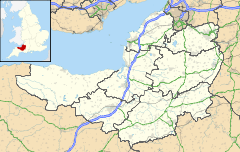Spaxton
| Spaxton | |
 St. Margaret's church |
|
 Court Farm |
|
|
|
|
| Population | 1,012 (2012)[1] |
|---|---|
| OS grid reference | ST225375 |
| District | Sedgemoor |
| Shire county | Somerset |
| Region | South West |
| Country | England |
| Sovereign state | United Kingdom |
| Post town | BRIDGWATER |
| Postcode district | TA5 |
| Dialling code | 01278 |
| Police | Avon and Somerset |
| Fire | Devon and Somerset |
| Ambulance | South Western |
| EU Parliament | South West England |
| UK Parliament | Bridgwater and West Somerset |
Lua error in package.lua at line 80: module 'strict' not found.
Spaxton is a small village and civil parish on the Quantocks in the Sedgemoor district of Somerset, South West England.
Contents
History
Spaxton was part of the hundred of Cannington.[2]
The parish includes the village of Aisholt which is one of the Thankful Villages - those villages that suffered no fatalities during the Great War of 1914-1918, and contains the 14th century Church of All Saints.[3] Also in the parish is the village of Charlynch (or Charlinch) where, around 1850 Henry James Prince the founder of the Agapemonites was ordained to the curacy of Charlinch, where he had sole charge in the illness and absence of the rector, the Rev. Samuel Starkey. The Church of St Mary was an Anglican Parish Church, but has now been deconsecrated. It dates from the 11th century with a tower probably of 1867. It has been designated by English Heritage as a Grade I listed building.[4] It contains monuments and tablets to the family of Admiral Robert Blake.
The name of Spaxton originates from "Spakr", a Dane who settled in the area in about the 9th century.[5] An alternative derivation relies on it being recorded as Spacheston in the Domesday Book, meaning 'The councillor's enclosure', from the Old English spæcas and tun. It was the property of Alfred of Spain.[6]
During the 19th century, the village was home to the notorious religious cult of the Agapemone.[7]
Governance
The parish council has responsibility for local issues, including setting an annual precept (local rate) to cover the council’s operating costs and producing annual accounts for public scrutiny. The parish council evaluates local planning applications and works with the local police, district council officers, and neighbourhood watch groups on matters of crime, security, and traffic. The parish council's role also includes initiating projects for the maintenance and repair of parish facilities, as well as consulting with the district council on the maintenance, repair, and improvement of highways, drainage, footpaths, public transport, and street cleaning. Conservation matters (including trees and listed buildings) and environmental issues are also the responsibility of the council.
The village falls within the Non-metropolitan district of Sedgemoor, which was formed on 1 April 1974 under the Local Government Act 1972, having previously been part of Bridgwater Rural District,[8] which is responsible for local planning and building control, local roads, council housing, environmental health, markets and fairs, refuse collection and recycling, cemeteries and crematoria, leisure services, parks, and tourism.
Somerset County Council is responsible for running the largest and most expensive local services such as education, social services, libraries, main roads, public transport, policing and fire services, trading standards, waste disposal and strategic planning.
It is also part of the Bridgwater and West Somerset county constituency represented in the House of Commons of the Parliament of the United Kingdom. It elects one Member of Parliament (MP) by the first past the post system of election, and part of the South West England constituency of the European Parliament which elects seven MEPs using the d'Hondt method of party-list proportional representation.
Geography
Near the village is Hawkridge Reservoir which supplies water for Bridgwater, constructed between 1960 and 1962,[9] and the Ashford Reservoir which was constructed in 1932.
Landmarks
Gothelney Hall at Gothelney Green was built in the 15th century and has been designated as a Grade I listed building.[10] To the south is Barford Park.
Religious sites
The Church of St Margaret has some parts from the 12th and 13th centuries but is predominantly from the 15th century, and was restored in 1895. It has been designated by English Heritage as a Grade I listed building.[11]
The Church Of All Saints, Aisholt dates from the 14th and 15th centuries.[12][13]
References
- ↑ Lua error in package.lua at line 80: module 'strict' not found.
- ↑ Lua error in package.lua at line 80: module 'strict' not found.
- ↑ Lua error in package.lua at line 80: module 'strict' not found.
- ↑ Lua error in package.lua at line 80: module 'strict' not found.
- ↑ Lua error in package.lua at line 80: module 'strict' not found.
- ↑ Lua error in package.lua at line 80: module 'strict' not found.
- ↑ Lua error in package.lua at line 80: module 'strict' not found.
- ↑ Lua error in package.lua at line 80: module 'strict' not found.
- ↑ Lua error in package.lua at line 80: module 'strict' not found.
- ↑ Lua error in package.lua at line 80: module 'strict' not found.
- ↑ Lua error in package.lua at line 80: module 'strict' not found.
- ↑ Lua error in package.lua at line 80: module 'strict' not found.
- ↑ Lua error in package.lua at line 80: module 'strict' not found.
External links
| Wikimedia Commons has media related to Spaxton. |



